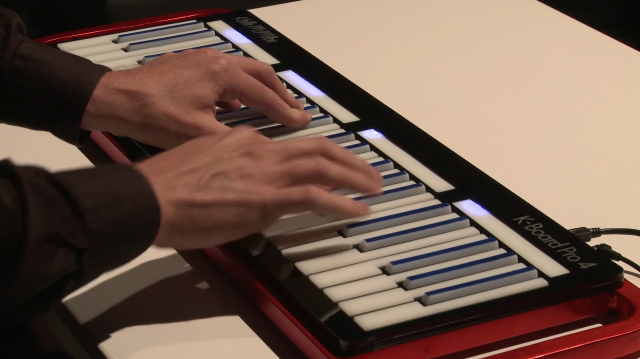
At the 2016 NAMM Show, Keith McMillen Instruments was previewing their K-Board Pro 4 – a four octave MIDI keyboard controller that offers true three-dimensional control, per key.
The K-Board Pro 4 is a Class-Compliant USB-powered MIDI contorller that captures velocity, continuous pressure, and both horizontal and vertical position. This gives you continuous expressive control over individual notes, not offered by traditional keyboards.
Here’s a video demo from the show floor, via Kraft Music:
Under each key of K-Board Pro 4 is the KMI’s Smart Sensor Fabric. This is the same technology used in all of their MIDI control surfaces.
The K-Board Pro 4 also has no moving parts, and KMI says that it will have their ‘trademark durability.’ Previously, KMI has demoed the durability of their devices by pouring beer on them and throwing them out the window.
The K-Board Pro 4 will be priced at US $495 and is expected to be available sometime in Q4 2016. See the KMI site for more info.

Wow. The Seaboard has a fight on it’s hands now. I’m glad because I thought it was stupid overpriced. Also, I haven’t tried it, but the “hot dog” style keys seemed weird to me.
You meant the Seaboard Grand? The Seaboard Rise is closer in price than the Grand and does not have ‘hotdog ‘style keys (the tops of the waveguides are flattened specifically on the ‘black keys’).
Also, the Rise and the K-Board are controllers (you do get a VST with the Rise), whereas the Seaboard Grand includes an onboard synth engine, so understably it’s more expensive.
I based my opinion on the way it looked. Haven’t touched on yet. My bad. I think the Seabord is neat, don’t get me wrong. I’m just glad this is catching on and there’s some more attempts.
Both the Seaboard and the K-board lack “key travel” so velocity must be just some kind of “strike force”.
My best guess about how expressive these instruments are, and how they might feel to play them comes from watching these demo vids. Unfortunately, I’m not seeing it. That’s not to say one couldn’t develop a very sophisticated and expressive connection to this instrument. But before I’d be willing to invest any money or time, I’d need to see someone else make it look both fun, effective and beautiful sounding.
They need to get more sensitive musicians to demo these new controllers. When they do Rhodes sounds with the K-Board Pro 4, it highlights the fact that the vertical movement of a traditional keyboard is an intrinsic part of the gestures that control the iconic Rhodes sound, the opposite of what they want to demonstrate.
I have no doubt that this could be a very expressive controller in the right hands. Check out what continuum users are doing foe some examples of how to do MPE right.
the continuum has a lot more sensitivity than all of the other controllers. You can effectively use it as an envelope besides other duties. Unfortunately it is obscenely expensive. I probably wouldn’t discuss about any of the other controllers if it was more sensibly priced..
I just want to know what the 4 white ribbon strips on the top can be assigned too 🙂
everything you want….
That’s ROLI’s Equator it’s being demoed with
Can’t wait for the inevitable video of Jordan F. Rudess “shredding” this thing.
I don’t think ROLI would approve of that
ROLI is less concerned about competition from other MPE controllers than it is about getting people on board with the MPE standard.
They were showing competitor’s products at their booth at NAMM, including the LinnStrument and the Madrona SoundPlane, because they know that ROLI’s success depends on widespread adoption of MPE.
And the demos that Rudess was doing in the ROLI booth featured other company’s software synths, being played via MPE from Rise controllers.